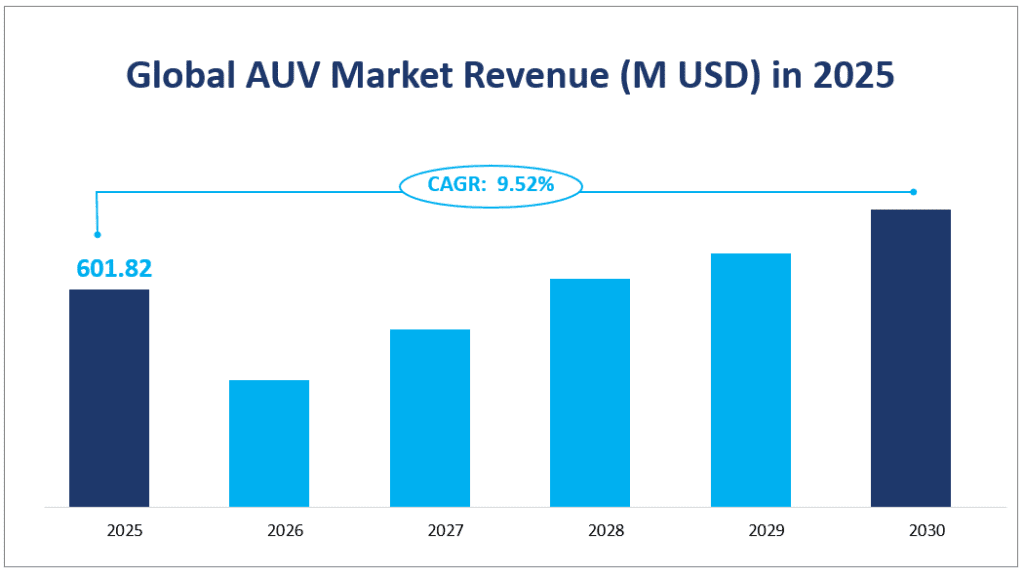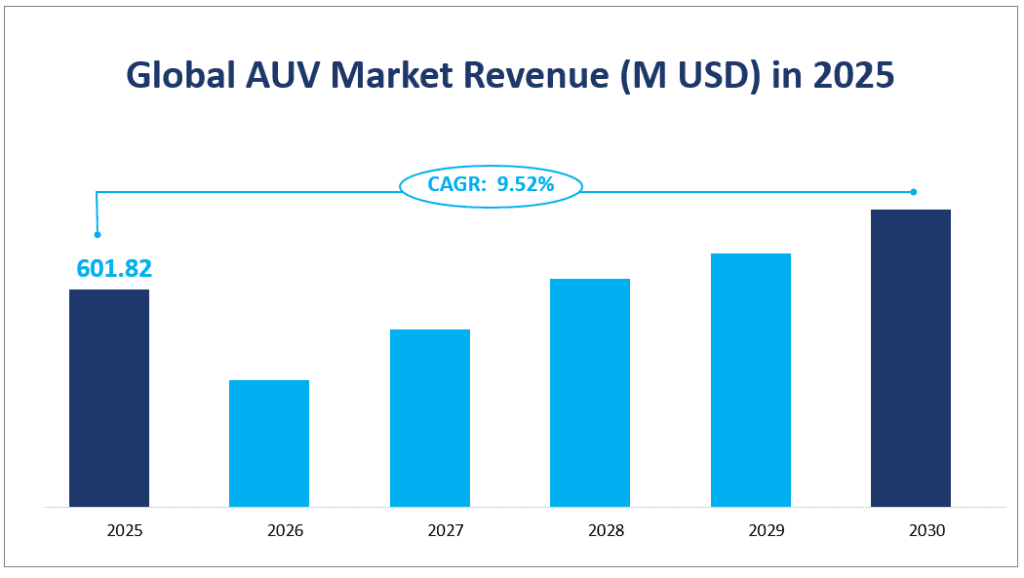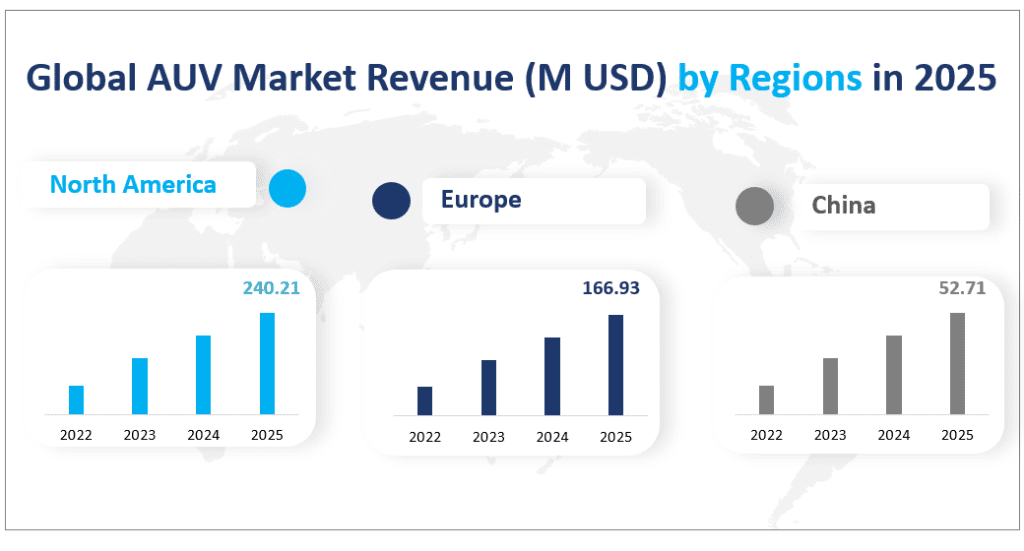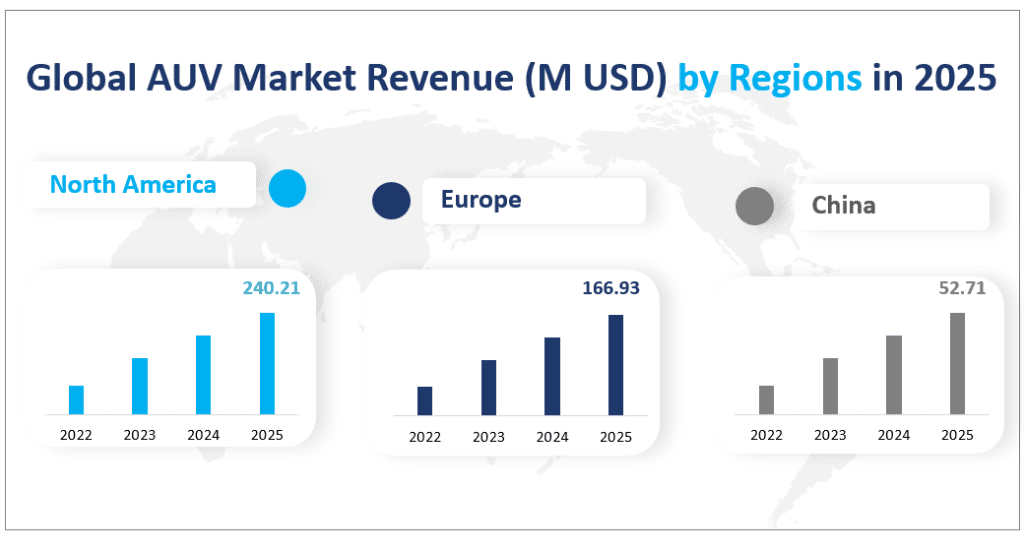1. Global Automatic Underwater Vehicle (AUV) Market Projections
The global AUV market revenue is forecasted to reach $601.82 million in 2025 with a CAGR of 9.52% from 2025 to 2030.
An automatic Underwater Vehicle (AUV) is an unmanned underwater robot capable of independently completing pre-programmed missions. These vehicles are designed to operate autonomously, collecting vast amounts of data through photo stitching and various sensors. AUVs are used in a wide range of applications, including oceanographic research, seabed mapping, and environmental monitoring. They are particularly valuable in industries such as oil and gas, where they can perform detailed surveys and inspections of subsea infrastructure. The ability of AUVs to navigate complex underwater environments and gather high-resolution data makes them indispensable tools for modern maritime operations.
Global AUV Market Revenue (M USD) in 2025


2. Driving Factors of AUV Market
Firstly, the increasing oil and gas industry demand is a significant driver. As traditional onshore reserves deplete, offshore resources are becoming more critical in meeting global energy needs. AUVs offer a cost-effective alternative to traditional deep-water drilling operations, eliminating the need for surface vessels and enabling autonomous underwater exploration. This has led to a surge in the use of AUVs for pipeline inspections, seabed mapping, and subsea infrastructure surveys.
Another driving factor is the growing interest in military applications. Nations around the world are increasingly focusing on maritime security and defense, leading to a higher demand for advanced underwater surveillance and reconnaissance technologies. AUVs are being developed for anti-submarine warfare, mine countermeasures, and underwater intelligence gathering. Their ability to operate autonomously and in challenging underwater conditions makes them ideal for modern naval operations.
Scientific research is another major application area for AUVs. These vehicles are used to study lakes, oceans, and the ocean floor, providing valuable data on water quality, marine life, and geological formations. The integration of advanced sensors and imaging technologies allows AUVs to collect detailed information that is crucial for environmental monitoring and scientific discovery.
3. Limiting Factors of AUV Market
Despite the numerous opportunities, the AUV market faces several challenges that could limit its growth. One of the primary limitations is the high operational costs associated with AUVs. The deployment of these vehicles for exploration or survey activities involves significant expenses, which can be a barrier to widespread adoption. Additionally, the maintenance, manufacturing, and research and development (R&D) costs are substantial, further contributing to the financial burden.
Another limiting factor is the limited scope and duration of tasks that AUVs can perform. Energy technology remains a technical challenge, with the underwater working time, sailing distance, speed, and load capacity of AUVs being directly affected by energy limitations. Current battery technologies have limitations in terms of specific energy, energy density, safety, and service life, which restrict the endurance and capabilities of AUVs.
Security concerns also pose a threat to the AUV market. As unmanned systems become more prevalent in various applications, they become increasingly vulnerable to cyber-attacks. The integrity of data and network systems is crucial for the effective operation of AUVs, and any breach could have significant consequences.
Finally, poor underwater communication conditions can hinder the effectiveness of AUVs. Underwater acoustic communication, while effective over long distances, faces challenges such as signal attenuation, multipath interference, and limited bandwidth. These issues can limit the communication range and data transmission capabilities of AUVs, affecting their overall performance.
4. Global AUV Market Segment
Product Types
Among these, Large AUVs are expected to hold the largest market share in 2025, accounting for nearly 49.69% with a market revenue of $299.06 million. This dominance is attributed to their versatility and ability to perform complex missions at greater depths, making them indispensable for deep-sea exploration, military operations, and advanced scientific research.
In terms of growth rates, Shallow AUVs are projected to exhibit the fastest growth rate. This rapid growth is driven by the increasing demand for cost-effective and accessible underwater solutions in applications such as shallow water surveys, environmental monitoring, and coastal defense. Shallow AUVs are particularly attractive for industries that require frequent and relatively simple underwater operations, as they offer a balance between affordability and functionality.
Medium AUVs are also expected to grow steadily with a market size of $203.59 million in 2025. These vehicles cater to a wide range of applications, including oil and gas pipeline inspections, mid-depth oceanographic research, and military reconnaissance. Their ability to operate at depths up to 1,000 meters makes them suitable for a variety of missions that require moderate depth capabilities.
Market by Applications
Among these applications, the Military sector is expected to hold the largest market share in 2025, accounting for approximately 54.98% with a market revenue of $330.85 million. The military application of AUVs is driven by the increasing need for advanced underwater surveillance, reconnaissance, and anti-submarine warfare capabilities. Nations around the world are investing heavily in AUV technologies to enhance their maritime defense and security.
The Oil & Gas sector is also a significant contributor to the AUV market, with a projected market share of 18.62% with a market value of $112.04 million in 2025. The demand for AUVs in this sector is driven by the need for efficient and cost-effective solutions for subsea infrastructure inspections, pipeline surveys, and environmental impact assessments. As traditional onshore reserves deplete, the importance of offshore exploration and production continues to grow, fueling the demand for AUVs.
Scientific Research is another key application area, with a projected market share of 19.02% with a market revenue of $114.46 million in 2025. AUVs are increasingly used in oceanographic research, environmental monitoring, and deep-sea exploration. Their ability to collect high-resolution data and operate autonomously makes them invaluable tools for scientific missions.
In terms of growth rates, the Oil & Gas application is projected to exhibit the fastest growth rate. This rapid growth is driven by the increasing demand for efficient and cost-effective solutions for subsea operations. As the industry shifts towards more complex and deeper offshore projects, the need for advanced AUV technologies continues to rise.
Market Revenue and Share by Segment
| Market Revenue (M USD) in 2025 | Market Share in 2025 | ||
| By Type | Shallow AUVs | 99.17 | 16.48% |
| Medium AUVs | 203.59 | 33.83% | |
| Large AUVs | 299.06 | 49.69% | |
| By Application | Oil & Gas | 112.04 | 18.62% |
| Military | 330.85 | 54.98% | |
| Scientific Research | 114.46 | 19.02% | |
| Others | 44.47 | 7.39% |
5. Regional AUV Market Analysis
Among these regions, North America is expected to hold the largest market share in 2025 with a market revenue of $240.21 million. This dominance is attributed to the region’s advanced technological infrastructure, strong presence of key manufacturers, and significant investments in R&D and defense applications.
Europe follows closely with a projected market value of $166.93 million, driven by the United States’ substantial demand for AUVs in both military and commercial applications. The region benefits from a robust industrial base and continuous technological advancements, making it a key player in the global AUV market.
Asia-Pacific is also a significant contributor, the region’s growth is fueled by increasing demand from emerging economies such as China, where AUVs are increasingly used in oil and gas exploration, scientific research, and maritime security with a market value of $52.71 million in 2025.
In terms of growth rates, Latin America is expected to exhibit the fastest growth rate from 2022 to 2025, with a CAGR of approximately 15.00%.
Global AUV Market Revenue (M USD) by Regions in 2025


6. Top 3 Companies in the AUV Market
Company Introduction and Business Overview:
Kongsberg Maritime is a leading global provider of maritime solutions, including advanced navigation systems, subsea technologies, and autonomous underwater vehicles. Established in 1814, the company has a strong presence in the United States and operates worldwide. Kongsberg Maritime is renowned for its innovative solutions and commitment to technological excellence.
Products Offered:
Kongsberg Maritime offers a range of AUVs, including the HUGIN series, which is available in several configurations and depth ratings (up to 6,000 meters). These AUVs are equipped with state-of-the-art sensors and navigation systems, making them ideal for high-resolution seabed mapping, pipeline inspections, and military applications.
In 2022, Kongsberg Maritime reported a revenue of $66.07 million from its AUV business.
Company Introduction and Business Overview:
Teledyne Benthos is a subsidiary of Teledyne Technologies, specializing in the design and manufacture of rugged and reliable oceanographic instrumentation and sensor solutions. Established in 1962, the company is headquartered in North Falmouth, Massachusetts, USA. Teledyne Benthos is known for its innovative solutions in underwater communication and autonomous vehicle technology.
Products Offered:
Teledyne Benthos offers the Gavia AUV, which is designed for a wide range of applications, including environmental monitoring, coastal surveys, and military reconnaissance. The Gavia AUV is compact, modular, and highly flexible, making it suitable for various underwater missions.
In 2022, Teledyne Benthos reported a revenue of $42.60 million from its AUV business.
Company Introduction and Business Overview:
Lockheed Martin Corporation is a global security and aerospace company with a strong focus on defense, space, and advanced technology systems. Established in 1995, the company is headquartered in Bethesda, Maryland, USA. Lockheed Martin is renowned for its innovative solutions in defense and security, including the development of advanced AUVs.
Products Offered:
Lockheed Martin offers a range of AUVs, including the A-Size Autonomous Underwater Vehicles (AUVs) and the EMATT MK 39 Expendable Mobile ASW Training Target. These vehicles are designed for various applications, including anti-submarine warfare, underwater reconnaissance, and environmental monitoring.
In 2022, Lockheed Martin reported a revenue of $41.50 million from its AUV business.
Major Players
| Company | Plants Distribution | Sales Region |
| Kongsberg Maritime | USA | Worldwide |
| Teledyne Benthos | Iceland | Worldwide |
| Lockheed Martin Corporation | USA | Mainly in North America |
| General Dynamics | USA | Mainly in North America |
| Boeing | USA | Mainly in USA |
| ATLAS ELEKTRONIK GmbH | Germany | Mainly in Europe |
| ECA Group | France | Mainly in Europe |
| Ocean Aero Inc. | USA | Mainly in USA |
| L3Harris Technologies | USA | Mainly in USA |
| Saab Seaeye Limited | UK | Mainly in Europe |
| International Submarine Engineering Ltd. | Canada | Mainly in North America |
| RTSYS | France | Mainly in Europe |
1 Automatic Underwater Vehicle (AUV) Market Overview
1.1 Product Overview and Scope of Automatic Underwater Vehicle (AUV)
1.2 Automatic Underwater Vehicle (AUV) Segment by Type
1.2.1 Global Automatic Underwater Vehicle (AUV) Sales and CAGR Comparison by Type (2017-2029)
1.3 Global Automatic Underwater Vehicle (AUV) Segment by Application
1.3.1 Automatic Underwater Vehicle (AUV) Consumption Comparison by Application (2017-2029)
1.3.2 The Market Profile of Oil & Gas
1.3.3 The Market Profile of Military
1.3.4 The Market Profile of Scientific Research
1.4 Global Automatic Underwater Vehicle (AUV) Market, Region Wise (2017-2022)
1.4.1 Global Automatic Underwater Vehicle (AUV) Market Size (M USD) and CAGR Comparison by Region (2017-2022)
1.4.2 United States Automatic Underwater Vehicle (AUV) Market Status and Prospect (2017-2022)
1.4.3 Europe Automatic Underwater Vehicle (AUV) Market Status and Prospect (2017-2022)
1.4.4 China Automatic Underwater Vehicle (AUV) Market Status and Prospect (2017-2022)
1.4.5 Japan Automatic Underwater Vehicle (AUV) Market Status and Prospect (2017-2022)
1.4.6 India Automatic Underwater Vehicle (AUV) Market Status and Prospect (2017-2022)
1.4.7 Southeast Asia Automatic Underwater Vehicle (AUV) Market Status and Prospect (2017-2022)
1.4.8 Latin America Automatic Underwater Vehicle (AUV) Market Status and Prospect (2017-2022)
1.4.9 Middle East and Africa Automatic Underwater Vehicle (AUV) Market Status and Prospect (2017-2022)
1.5 Global Market Size of Automatic Underwater Vehicle (AUV) (2017-2029)
1.5.1 Global Automatic Underwater Vehicle (AUV) Revenue Status and Outlook (2017-2029)
1.5.2 Global Automatic Underwater Vehicle (AUV) Sales Status and Outlook (2017-2029)
2 Global Automatic Underwater Vehicle (AUV) Market Landscape by Player
2.1 Global Automatic Underwater Vehicle (AUV) Sales and Share by Player (2017-2022)
2.2 Global Automatic Underwater Vehicle (AUV) Revenue and Market Share by Player (2017-2022)
2.3 Global Automatic Underwater Vehicle (AUV) Average Price by Player (2017-2022)
2.4 Global Automatic Underwater Vehicle (AUV) Gross Margin by Player (2017-2022)
2.5 Automatic Underwater Vehicle (AUV) Manufacturing Base Distribution and Sales Area by Player
2.6 Automatic Underwater Vehicle (AUV) Market Competitive Situation and Trends
2.6.1 Automatic Underwater Vehicle (AUV) Market Concentration Rate
2.6.2 Automatic Underwater Vehicle (AUV) Market Share of Top 3 and Top 6 Players
2.6.3 Mergers & Acquisitions, Expansion
3 Automatic Underwater Vehicle (AUV) Upstream and Downstream Analysis
3.1 Automatic Underwater Vehicle (AUV) Industrial Chain Analysis
3.2 Key Raw Materials Suppliers
3.3 Key Raw Materials Supply and Demand Analysis
3.4 Manufacturing Process Analysis
3.5 Downstream Buyers
3.6 Value Chain Status Under COVID-19
4 Automatic Underwater Vehicle (AUV) Manufacturing Cost Analysis
4.1 Manufacturing Cost Structure Analysis
4.2 Automatic Underwater Vehicle (AUV) Key Raw Materials Cost Analysis
4.2.1 Key Raw Materials Introduction
4.2.2 Price Trend of Key Raw Materials
4.3 Labor Cost Analysis
4.3.1 Definition of Labor Cost
4.3.2 Labor Cost of North America
4.3.3 Labor Cost of Europe
4.3.4 Labor Cost of Asia-Pacific
4.3.5 Labor Cost of South America
4.3.6 Labor Cost of Middle East
4.3.7 Labor Cost of Africa
4.4 Energy Costs Analysis
4.5 R&D Costs Analysis
5 Market Dynamics
5.1 Drivers
5.2 Restraints and Challenges
5.3 Opportunities
5.3.1 Advances in Innovation and Technology for Automatic Underwater Vehicle (AUV)
5.3.2 Increased Demand in Emerging Markets
5.4 Automatic Underwater Vehicle (AUV) Industry Development Trends under COVID-19 Outbreak
5.4.1 Global COVID-19 Status Overview
5.4.2 Influence of COVID-19 Outbreak on Automatic Underwater Vehicle (AUV) Industry Development
5.5 Consumer Behavior Analysis
6 Players Profiles
6.1 Kongsberg Maritime
6.1.1 Kongsberg Maritime Basic Information, Manufacturing Base, Sales Area and Competitors
6.1.2 Automatic Underwater Vehicle (AUV) Product Profiles, Application and Specification
6.1.3 Kongsberg Maritime Automatic Underwater Vehicle (AUV) Market Performance (2017-2022)
6.1.4 Teledyne Benthos Business Overview
6.2 Teledyne Benthos
6.2.1 Teledyne Benthos Basic Information, Manufacturing Base, Sales Area and Competitors
6.2.2 Automatic Underwater Vehicle (AUV) Product Profiles, Application and Specification
6.2.3 Teledyne Benthos Automatic Underwater Vehicle (AUV) Market Performance (2017-2022)
6.2.4 Lockheed Martin Corporation Business Overview
6.3 Lockheed Martin Corporation
6.3.1 Lockheed Martin Corporation Basic Information, Manufacturing Base, Sales Area and Competitors
6.3.2 Automatic Underwater Vehicle (AUV) Product Profiles, Application and Specification
6.3.3 Lockheed Martin Corporation Automatic Underwater Vehicle (AUV) Market Performance (2017-2022)
6.3.4 Lockheed Martin Corporation Business Overview
6.4 General Dynamics
6.4.1 General Dynamics Basic Information, Manufacturing Base, Sales Area and Competitors
6.4.2 Automatic Underwater Vehicle (AUV) Product Profiles, Application and Specification
6.4.3 General Dynamics Automatic Underwater Vehicle (AUV) Market Performance (2017-2022)
6.4.4 General Dynamics Business Overview
6.5 Boeing
6.5.1 Boeing Basic Information, Manufacturing Base, Sales Area and Competitors
6.5.2 Automatic Underwater Vehicle (AUV) Product Profiles, Application and Specification
6.5.3 Boeing Automatic Underwater Vehicle (AUV) Market Performance (2017-2022)
6.5.4 Boeing Business Overview
6.6 ATLAS ELEKTRONIK GmbH
6.6.1 ATLAS ELEKTRONIK GmbH Basic Information, Manufacturing Base, Sales Area and Competitors
6.6.2 Automatic Underwater Vehicle (AUV) Product Profiles, Application and Specification
6.6.3 ATLAS ELEKTRONIK GmbH Automatic Underwater Vehicle (AUV) Market Performance (2017-2022)
6.6.4 ATLAS ELEKTRONIK GmbH Business Overview
6.7 ECA Group
6.7.1 ECA Group Basic Information, Manufacturing Base, Sales Area and Competitors
6.7.2 Automatic Underwater Vehicle (AUV) Product Profiles, Application and Specification
6.7.3 ECA Group Automatic Underwater Vehicle (AUV) Market Performance (2017-2022)
6.7.4 ECA Group Business Overview
6.8 Ocean Aero Inc.
6.8.1 Ocean Aero Inc. Basic Information, Manufacturing Base, Sales Area and Competitors
6.8.2 Automatic Underwater Vehicle (AUV) Product Profiles, Application and Specification
6.8.3 Ocean Aero Inc. Automatic Underwater Vehicle (AUV) Market Performance (2017-2022)
6.8.4 Ocean Aero Inc. Business Overview
6.9 L3Harris Technologies
6.9.1 L3Harris Technologies Basic Information, Manufacturing Base, Sales Area and Competitors
6.9.2 Automatic Underwater Vehicle (AUV) Product Profiles, Application and Specification
6.9.3 L3Harris Technologies Automatic Underwater Vehicle (AUV) Market Performance (2017-2022)
6.9.4 L3Harris Technologies Business Overview
6.10 Saab Seaeye Limited
6.10.1 Saab Seaeye Limited Basic Information, Manufacturing Base, Sales Area and Competitors
6.10.2 Automatic Underwater Vehicle (AUV) Product Profiles, Application and Specification
6.10.3 Saab Seaeye Limited Automatic Underwater Vehicle (AUV) Market Performance (2017-2022)
6.10.4 Saab Seaeye Limited Business Overview
6.11 International Submarine Engineering Ltd.
6.11.1 International Submarine Engineering Ltd. Basic Information, Manufacturing Base, Sales Area and Competitors
6.11.2 Automatic Underwater Vehicle (AUV) Product Profiles, Application and Specification
6.11.3 International Submarine Engineering Ltd. Automatic Underwater Vehicle (AUV) Market Performance (2017-2022)
6.11.4 International Submarine Engineering Ltd. Business Overview
6.12 RTSYS
6.12.1 RTSYS Basic Information, Manufacturing Base, Sales Area and Competitors
6.12.2 Automatic Underwater Vehicle (AUV) Product Profiles, Application and Specification
6.12.3 RTSYS Automatic Underwater Vehicle (AUV) Market Performance (2017-2022)
6.12.4 RTSYS Business Overview
7 Global Automatic Underwater Vehicle (AUV) Sales and Revenue Region Wise (2017-2022)
7.1 Global Automatic Underwater Vehicle (AUV) Sales and Market Share, Region Wise (2017-2022)
7.2 Global Automatic Underwater Vehicle (AUV) Revenue (M USD) and Market Share, Region Wise (2017-2022)
7.3 Global Automatic Underwater Vehicle (AUV) Sales, Revenue, Price and Gross Margin (2017-2022)
7.4 United States Automatic Underwater Vehicle (AUV) Sales, Revenue, Price and Gross Margin (2017-2022)
7.4.1 United States Automatic Underwater Vehicle (AUV) Market Under COVID-19
7.5 Europe Automatic Underwater Vehicle (AUV) Sales, Revenue, Price and Gross Margin (2017-2022)
7.5.1 Europe Automatic Underwater Vehicle (AUV) Market Under COVID-19
7.6 China Automatic Underwater Vehicle (AUV) Sales, Revenue, Price and Gross Margin (2017-2022)
7.6.1 China Automatic Underwater Vehicle (AUV) Market Under COVID-19
7.7 Japan Automatic Underwater Vehicle (AUV) Sales, Revenue, Price and Gross Margin (2017-2022)
7.7.1 Japan Automatic Underwater Vehicle (AUV) Market Under COVID-19
7.8 India Automatic Underwater Vehicle (AUV) Sales, Revenue, Price and Gross Margin (2017-2022)
7.8.1 India Automatic Underwater Vehicle (AUV) Market Under COVID-19
7.9 Southeast Asia Automatic Underwater Vehicle (AUV) Sales, Revenue, Price and Gross Margin (2017-2022)
7.9.1 Southeast Asia Automatic Underwater Vehicle (AUV) Market Under COVID-19
7.10 Latin America Automatic Underwater Vehicle (AUV) Sales, Revenue, Price and Gross Margin (2017-2022)
7.10.1 Latin America Automatic Underwater Vehicle (AUV) Market Under COVID-19
7.11 Middle East and Africa Automatic Underwater Vehicle (AUV) Sales, Revenue, Price and Gross Margin (2017-2022)
7.11.1 Middle East and Africa Automatic Underwater Vehicle (AUV) Market Under COVID-19
8 Global Automatic Underwater Vehicle (AUV) Sales, Revenue (M USD), Price Trend by Type
8.1 Global Automatic Underwater Vehicle (AUV) Sales and Market Share by Type (2017-2022)
8.2 Global Automatic Underwater Vehicle (AUV) Revenue and Market Share by Type (2017-2022)
8.3 Global Automatic Underwater Vehicle (AUV) Price by Type (2017-2022)
8.4 Global Automatic Underwater Vehicle (AUV) Sales Growth Rate by Type (2017-2022)
8.4.1 Global Automatic Underwater Vehicle (AUV) Sales Growth Rate of Shallow AUVs (Depth up to 100 meters) (2017-2022)
8.4.2 Global Automatic Underwater Vehicle (AUV) Sales Growth Rate of Medium AUVs (Depth up to 1,000 meters) (2017-2022)
8.4.3 Global Automatic Underwater Vehicle (AUV) Sales Growth Rate of Large AUVs (Depth more than 1,000 meters) (2017-2022)
9 Global Automatic Underwater Vehicle (AUV) Market Analysis by Application
9.1 Global Automatic Underwater Vehicle (AUV) Consumption and Market Share by Application (2017-2022)
9.2 Global Automatic Underwater Vehicle (AUV) Consumption Growth Rate by Application (2017-2022)
9.2.1 Global Automatic Underwater Vehicle (AUV) Consumption Growth Rate of Oil & Gas (2017-2022)
9.2.2 Global Automatic Underwater Vehicle (AUV) Consumption Growth Rate of Military (2017-2022)
9.2.3 Global Automatic Underwater Vehicle (AUV) Consumption Growth Rate of Scientific Research (2017-2022)
10 Global Automatic Underwater Vehicle (AUV) Market Forecast (2022-2029)
10.1 Global Automatic Underwater Vehicle (AUV) Sales, Revenue Forecast (2022-2029)
10.1.1 Global Automatic Underwater Vehicle (AUV) Sales and Growth Rate Forecast (2022-2029)
10.1.2 Global Automatic Underwater Vehicle (AUV) Revenue and Growth Rate Forecast (2022-2029)
10.2 Global Automatic Underwater Vehicle (AUV) Sales and Revenue Forecast, Region Wise (2022-2029)
10.2.1 United States Automatic Underwater Vehicle (AUV) Sales and Revenue Forecast (2022-2029)
10.2.2 Europe Automatic Underwater Vehicle (AUV) Sales and Revenue Forecast (2022-2029)
10.2.3 China Automatic Underwater Vehicle (AUV) Sales and Revenue Forecast (2022-2029)
10.2.4 Japan Automatic Underwater Vehicle (AUV) Sales and Revenue Forecast (2022-2029)
10.2.5 India Automatic Underwater Vehicle (AUV) Sales and Revenue Forecast (2022-2029)
10.2.6 Southeast Asia Automatic Underwater Vehicle (AUV) Sales and Revenue Forecast (2022-2029)
10.2.7 Latin America Automatic Underwater Vehicle (AUV) Sales and Revenue Forecast (2022-2029)
10.2.8 Middle East and Africa Automatic Underwater Vehicle (AUV) Sales and Revenue Forecast (2022-2029)
10.3 Global Automatic Underwater Vehicle (AUV) Sales, Revenue and Price Forecast by Type (2022-2029)
10.4 Global Automatic Underwater Vehicle (AUV) Consumption Forecast by Application (2022-2029)
10.5 Automatic Underwater Vehicle (AUV) Market Forecast Under COVID-19
11 Research Findings and Conclusion
12 Appendix
12.1 Methodology
12.2 Research Data Source
12.2.1 Secondary Data
12.2.2 Primary Data
12.2.3 Market Size Estimation
12.2.4 Legal Disclaimer
